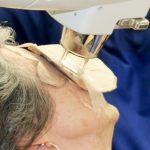Radiation Carcinogenesis
As acceptance of radiation therapy for skin cancer grows, questions arise as to the long-term risks therapeutic radiation poses. This is an area extensively measured and studied by radiation physicists and medical dosimetrists. However, from practical point of view, most of empirical data comes form epidemiological population studies. The most dramatic of these being atomic bomb and nuclear radiation fallout investigations. However, the more instructive data is derived from patients treated with radiation therapy for other cancers, tinea capitis (ringworm of the scalp), and acne. We reviewed the most relevant studies available to us to date.
Long term studies of radiation carcinogenesis are plagued with lack of consistency of radiation delivery over the last 5 decades. Past sources of radiation involved low energy soft x-rays (up to 12 KeV), Grenz X-rays (10-30 KeV), superficial radiation (50-200 KeV), orthovoltage machines (200-500 KeV), and megavoltage units such as Cobalt-60 at 1.25 MeV. The latter has been largely replaced with electron-producing linear accelerators in the megavoltage range. The kilovoltage machines and their manufacturers have largely disappeared until recently. Sensus SRT-100 machine has engendered a re-emergence of superficial radiotherapy technology in a new reliable user-friendly form. With its popularity growing rapidly among patients, examination of radiation carcinogenesis is needed.
Margaret Karagas in one of her very large population studies published in 1996 distilled the relative risk of BCCa in exposed patients to 2.3 (Joumal of the National Cancer Institute). Her study included patients treated with X-ray therapy for non-skin cancers, tinea capitis, and acne. Interestingly, most of the studies exclude patients treated with radiation for skin cancers. The risk was greatest for those treated for acne – relative risk of 3.3 for BCCa development in the future. Most of the acne patients were treated before 1960 with 60-100 KeV to a total dose of about 1400 rads (cGy). In 2007, Karagas evaluated updated population statistics again confirming the susceptibility for BCCa, and a risk for SCCa although with a smaller odds ratio (Epidemiology, 2007).
Higher relative risk for BCCa was reported out of Israel in studies of radiation for tinea capitis – 4.9 (Modan, Radiat Res, 1991), and in New York – relative risk of 6 (Shore, Radiat Res, 1984). Squamous cell carcinoma risk did not appear to be elevated, nor was the risk for melanoma. In correlating skin types with delayed cancer incidence, those susceptible to UV carcinogenesis were also more susceptible to BCCa development after X-ray radiation.
In 2000, Lichter reported that association with BCCa and SCCa was largely confined to radiotherapy 40 years or longer prior to diagnosis. He calculated Odds Ratio of 3.3 for BCCa and 2.9 for SCCa (not Relative Risk which would be lower). For acne radiotherapy, the Odds Ratio was even more dramatic – 17 for BCCa and 10 for SCCa.
All the studies have confirmed greater risk of cancers with younger age of irradiation and with radiotherapy for acne treatment. Although a 20 year delay in occurrence of BCCa was documented in most studies, this may be attributable to the young age of the population. It appears that skin irradiation is not an independent factor for carcinogenensis. The known risk factors for skin cancers (age and skin type) are almost “prerequisites” for skin cancer development after radiation.
Another pattern is that acne radiotherapy carries a much higher risk of skin cancers than other forms of radiation therapy. This can be explained by the principle of radiation biology known as surface integral exposure. Large areas of skin were treated for acne – face, neck, and back. The sheer surface area alone could explain the highest risk factor of carcinogenesis. Tinea Capitis treatment of scalp and its lower radiation dose also correlate with the surface integral exposure hypothesis.
Given this analysis, what is the relative risk of radiation carcinogenesis with the new generation of radiotherapy machines? The risk should be substantially lower than the aforementioned scenarios for several reasons. Superficial skin cancers are the primary pathology treated by superficial radiotherapy (SRT). The energies required are 50-70 kVp range, tapering rapidly at 5 -10 mm of skin depth. The area of treatment is most-commonly contained in a 3 cm diameter treatment port, thus dramatically reducing the surface integral exposure compared with older technologies and clinical applications. Also modern dose recommendations (time dose fractionation) streamline energies without overtreatment. What is left should be a very small increase in the risk of BCCa and a negligible risk of SCCa decades after treatment. At this point, an argument can be made that superficial radiotherapy (SRT) creates a minimal risk of trading a surgical treatment of the skin cancer now for surgical treatment of another BCCa 10-20 years later. With these assumptions, utilizing SRT for patients over 65 years of age only as Sensus recommends needs to be seriously questioned. The younger patients can also stand to benefit from this exciting new technology.

